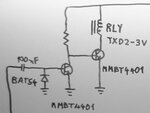neazoi
Advanced Member level 6
Hello I have this RF switch that is powered by 5V. Any RF at the base of the 1st transistor will deactivate the relay.
The circuit is powered by 5V (battery) but the relay I have available is a 3V one.
How can I use the 3v relay with this circuit?
Some thoughts:
1. place a resistor at the relay switching transistor emitter. (what value?)
2. place a 3V1 zener somewhere (where?), so the relay voltage is reduced when the battery voltage is 5v, but the relay can switch even when the battery voltage drops to 3.1v.
This second point is very convinient in my application, if it can be done.
The circuit is powered by 5V (battery) but the relay I have available is a 3V one.
How can I use the 3v relay with this circuit?
Some thoughts:
1. place a resistor at the relay switching transistor emitter. (what value?)
2. place a 3V1 zener somewhere (where?), so the relay voltage is reduced when the battery voltage is 5v, but the relay can switch even when the battery voltage drops to 3.1v.
This second point is very convinient in my application, if it can be done.
